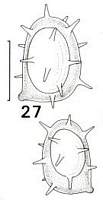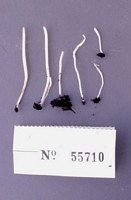|
 Clavaria mima Clavaria mima
BiostatusPresent in region - Indigenous. Endemic
Images (click to enlarge)
Caption: Fig. 27 Clavaria mima. TENN no. 43608. Scale bar = 5 µm. | 
Caption: Microfiche1-20. Clavaria mima. TENN 43608. |
Article: Petersen, R.H. (1988). The clavarioid fungi of New Zealand. New Zealand Department of Scientific and Industrial Research, Bulletin 236: 170 pp. Wellington:.
Description: Fruit bodies up to 45 x 2.5 mm, simple clubs, scattered to cespitose in pairs. Stipe up to 17x2
mm, terete, arising from a very small mycelial pad, off white, appearing silky. Club very pale
dull yellow to ivory ("cartridge-buff'), terete to slightly sulcate, appearing waxy; apex
broadly rounded. Taste and odour negligible.
Tramal hyphae of club 3-7 µm diam., clampless, parallel, tightly packed hyaline.
Subhymenium extensive, pseudoparenchymatous. Hymenium thickening; basidia 35-2x7-8
µm, clavate, bifurcate or clamped, persistent after spore discharge; contents homogeneous to
uniguttulate when mature; sterigmata 4, slender, curved-erect, up to 8 µm long.
Spores 5.8-6.8 x 4-4.7 µm (E = 1.31-1.64; Em = 1.46; Lm = 6.30 µm), narrowly ovate to
ellipsoid, flattened adaxially, thin-walled, delicately spinulose; contents uniguttulate when
mature; hilar appendix broad, papillate; ornamentation of very slender spinules up to 1.2 µm
long.
Notes: Clavaria mima is so named because it mimics C. acuta, C. subacuta, C. gibbsiae, and others
with pale, slender fruit bodies. In all respects, it closely resembles C. californica which
produces very similar (but larger) fruit bodies and spores which differ only in size. A
distributional range from western North America to New Zealand would match that reported
for Clavicorona piperata (q.v.), but would otherwise be unique. I consider the differences in
distribution and spore dimensions enough to keep them as separate taxa, even though I have
seen only one specimen of the New Zealand taxon.
|